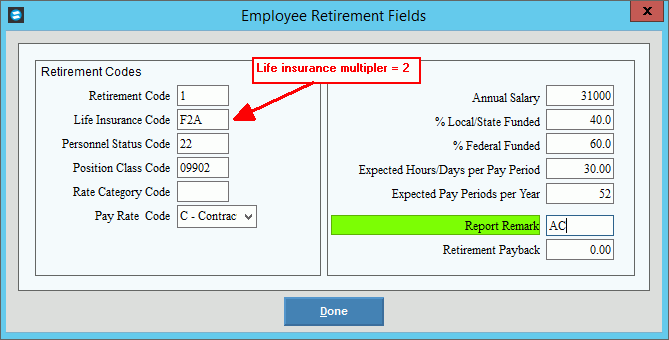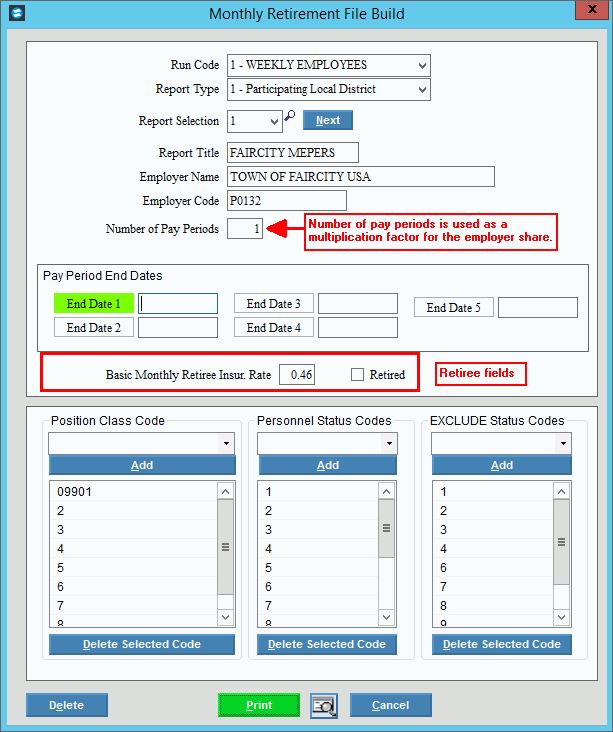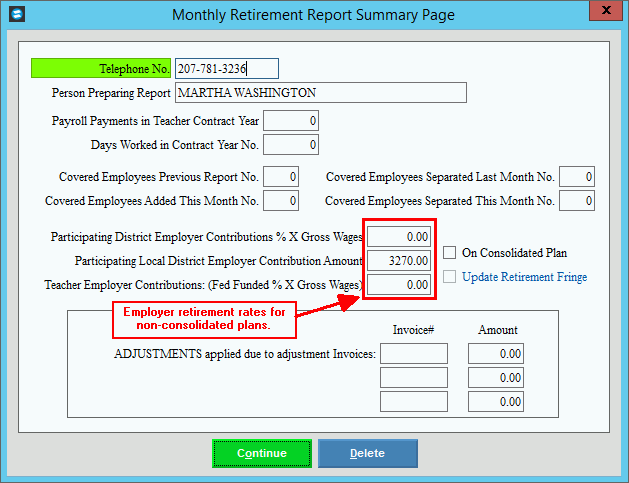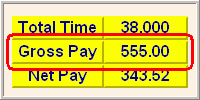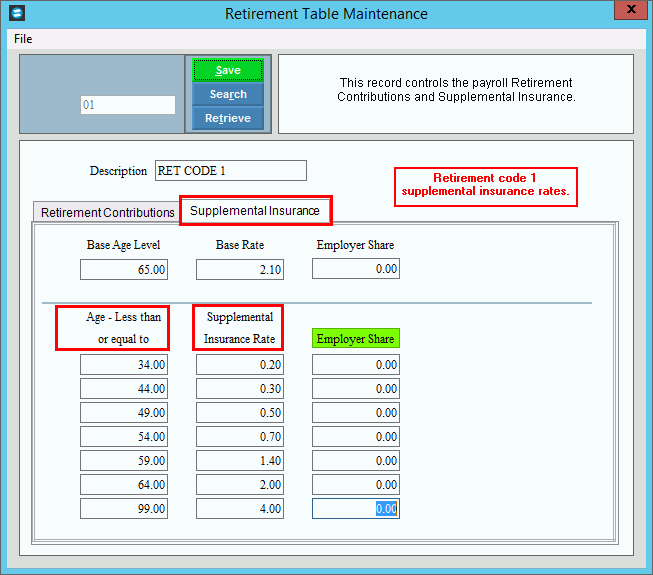Setting Up Payroll for the MainePERS, click More.
NDS Support will assist you in setting up Payroll to process your MainePERS information. The following programs contain fields relating to the MainePERS:
Retirement Table (RET%nn): Contains the general rates and amounts used to calculate the retirement contributions and insurance premiums. You must create a separate table for each retirement code.
Employee Maintenance - Employee Retirement Fields Area: Contains retirement and life insurance premium fields for each employee. You must assign the retirement code to the employee.
Employee Maintenance - Employee Retirement Insurance Area: Contains the flat retirement contribution amount for a retiree, which overrides the retiree rate.
Other Pay Maintenance: Although the MainePERS deductions are usually only calculated for regular pay, you can also set up retirement information for specific other pay codes.
Benefit Plan Codes BPLANnn: - Contains the codes pertaining to the plans used by employees in your organization and is used for MSR Magnetic filing.
MSR Plan Codes: Contains the plan codes for the retirement consolidated plan. The plan codes contain the consolidated information including the rates for the employer's retirement contribution. This information is used for calculations on the consolidated summary page that part of the MSR Build Monthly Work File.
Tip: For Non-Consolidated rates, see the prompt for the MSR Build Monthly Work File.MSR Deductions Table Maintenance (MSR DEDS): Maintains the setup for the optional payment of MainePERS benefits via the Vendor Invoices and Checks feature.
Tips:
You do not need to create deduction codes for retirement, because they are standard deductions that are handled separately from other payroll deductions.
Exception: If you use the Vendor Invoices and Checks Feature to pay retirement benefits, you must set up deductions and the associated fringe benefits. For more information, see the Understanding Retirement Fringe Benefits topic.Each retirement code must have an associated retirement table defined during Retirement Table Maintenance (RET%nn), where nn represents the Retirement Code.
Retirement Table Fields, click More.
The Retirement Tables are the foundation for the MainePERS processing. Payroll uses the retirement table fields to calculate the deductions and employer paid portion associated with retirement contributions and life insurance premiums.
Tips:
Each retirement code must have its associated retirement information maintained in the Retirement Table Maintenance (RET%nn). The retirement table store rates and calculation factors for the deductions and employer paid benefits associated with retirement contributions and life insurance premiums.
Reserved Retirement Codes:
0 = No Retirement: Retirement code 0 (zero) is reserved for No Retirement or Maine State Insurance. You can not create a table for retirement code 0.
5 = Retired: Use retirement code 5 for retirees. Set up a retirement table for retirement code 5 during Retirement Table Maintenance.
nn = Withdrawn (where nn is not 0 or 5): Create a specific retirement code for employees who have withdrawn from the retirement plan. To handle W-2 processing properly, set up a corresponding retirement table during Retirement Table Maintenance and enter 0.00 (zeros) in all of the fields.

Employee Deduction Fields:
Retirement Rate: Rate for calculating the deduction for the retirement contribution.
Basic Ins Rate: Rate for calculating the deduction for the basic life insurance premium.
Supplemental Ins Rate: Click the Supplemental Insurance Rate tab to maintain the age-based rates for calculating the deduction for the supplemental life insurance premium.
Dependent Ins Amt Per Pd: Amount of the deduction (per pay period) for the dependent life insurance premium.
Tip: This is a flat amount, not a rate.Basic Ins Ex Amount: Exemption amount subtracted from the MainePERS annual salary, which creates a starting point for deducting the employee's portion of the MainePERS basic life insurance premium.
Supplemental Ins Ex Mult/Amount: Factor used to calculate the starting point for when the employee's portion of the MainePERS supplemental life insurance premium deduction kicks in. Unlike the basic exemption which is always a flat amount, the supplemental exemption can contain either a flat exemption amount or a multiplier value.
Employer Benefit Fields:
Retirement Rate: Always leave this zero in the table. See MSR Plan Codes Maintenance and the MSR Build Monthly Work File for the consolidated and non-consolidated employer paid rates.
Basic Ins Rate: Rate for calculating the employer paid benefit for the basic life insurance premium.
Supplemental Ins Rate: Open the supplemental insurance rate table that contains age-based rates for calculating the employer paid benefit for the supplemental life insurance premium.
Dependent Ins Amt Per Pd: Amount of the employer paid benefit (per pay period) for the dependent life insurance premium.
Tip: This is a flat amount, not a rate.Basic Ins Base: Annual salary cap for limiting the employer's portion of the MainePERS basic life insurance premium benefit. When the annual gross earnings amount reaches the cap, the employer's payments are limited to the cap amount; they do not increase as the annual earnings amount increases. When calculating the adjusted annual salary amount, the annual gross earnings is used or this base amount - whichever is less.
Supplemental Ins Base: Annual salary cap for limiting the employer's portion of the supplemental life insurance premium benefit for MainePERS. When the employee's gross earnings amount reaches the cap, the employer's payments are limited to the cap amount. They do not increase as the annual earnings amount increases. When calculating the adjusted annual salary amount, the annual gross earnings is used or this base amount - whichever is less.
Handling Retirees, click More.
The life insurance premium for retired employees is handled separately from other MainePERS calculations. There are two methods for retirees:
Rate: You can enter a basic monthly retiree rate at the prompt for the MSR Build Monthly Work File, which applies to all employees included in the work file.
Flat Amount: You can maintain a retiree insurance amount for individual employees during Employee Maintenance - Employee Retirement Insurance Area.
Tip: If a flat amount exists for an employee, it overrides the amount calculated using the rate.
Notes:
Assign retirement code 5 to retired employees.
The fields for the retirement code 5 in the Retirement Table (RET%nn) should all be zeros.
Employee Deductions Versus Employer Paid Portion, click More.
The following table highlights the differences between the employee deductions and the employer fringes for the retirement contributions and life insurance premiums.
Description |
Employee Deductions |
Employer Paid Amounts |
Calculations performed by... |
Payroll Check Entry calculates special standard deductions. |
The Build Monthly Work File and Retirement Detail Report perform calculations. The Build Monthly Work File generates the employer paid amounts. |
Amounts posted to Vendor Invoices and Checks by... |
(or Post to Vendor Transaction Files, if active) |
Build Monthly Work File followed by Retirement Fringe Post |
Total employee amounts for reports... |
Report totals for each employee come from employee month-to-date values. |
Report totals for each employee are calculated using the number of periods from the report prompt. |
Salary Amount for retirement contribution calculations... |
Calculation use the gross pay amount calculated during Check Entry. |
Calculation uses earnable compensation, which is the local or state funded earnings + the federally funded earnings |
Salary Amount for insurance calculations... |
Calculation uses the estimated annual salary maintained during Employee Maintenance - Employee Retirement Fields Area. |
Calculations use the estimated annual salary maintained during Employee Maintenance - Employee Retirement Fields Area. |
The MainePERS Reports, click More.
Employee Retirement Edit List: Prints the employee master fields associated with the MainePERS.
MSR Build Monthly Work File: Generates the monthly retirement information required by the state retirement office. This report also generates transactions for fringe processing.
Retirement Detail Report: Prints the retirement and insurance information including break-downs of the employee's share and the employer's share.
MSR Magnetic Media Detail Listing: Lists the employee and retirement information from the Build Monthly Work File routine that is being sent to the state.
Retirement Fringe Journal: Prints the transactions posted by the Build Monthly Work File.
Tips:This report is applicable only if you pay the retirement benefits via the Vendor Invoices and Checks system.
For more information, see the Understanding Retirement Fringe Benefits topic.
The MSRS Magnetic Filing, click More.
Run the MSR Magnetic Filing steps listed below after the final payroll for the month has been posted and before you do the payroll month end.
1. Make sure the correct versions of the Build Monthly Work File were run.
2. Confirm the setup in MSR Transmitter Maintenance. If you are in the test phase, set the Filing Type accordingly. Reset the Filing Type when your transmissions go live.
3. Run the MSR Build Export Work File routine to process the data from the Build Monthly Work File. You must select the same report selection number as you did for the Build Monthly Work File routine. Be sure to update the month and year so that the export file name reflects the correct time period.
4. Run the Magnetic Media Detail Listing. Use the report to verify that the MainePERS information in the monthly work file is accurate.
5. Edit the Export Work File if necessary. Note: If changes need to be made to the MSR Magnetic file and you have not done your PR month end yet, then you can re-run the Build Monthly Work File. However, if you have done your PR month end use the following routines to make changes if the employee details or summary details need to be changed or removed.
1. Detail Maintenance - use to edit employee information or remove employees.
2. Recalculate Summary Record Totals - use to recalculate MSR totals if employee detail is changed.
3. Summary Maintenance - If changes are made and the summary was recalculated, you can use the Summary Maintenance to verify that the summary totals are correct.
6. Run the MSR Export MSR File routine to create the transmission file at the location specified on the Export Destination Maintenance.
7. By the 15th day following the end of the month, follow the MainePERS instructions to transmit the export file to the state. To sign on, navigate to the www.mainepers.org website.
The Flow for Retirement Processing, click More.
Most facilities run the retirement processing either monthly or biweekly.
Tip: For more information about the how the retirement programs fit in with the rest of the payroll processing, see the Payroll Runbook.
1. Payroll Check Entry: Calculates the retirement contributions and life insurance premiums for employees as standard deductions.
2. Payroll Post: Updates the employee month-to-date retirement deductions.
3. MSR
Build Monthly Work File: Calculates the retirement contributions
and life insurance premiums for the employer.
Tip: If you use the Vendor
Invoices and Checks feature, be sure to select the Update
Retirement Fringe option.
4. MSR Magnetic Media Detail Listing: (Optional) Reports the information in the Build Monthly Work file that will be sent to MainePERS.
5. MSR Build Export Work File: Generates an export file containing the MainePERS information.
6. MSR Export MSR File: Exports the retirement information to an export transmission file at a specified location where it can later be uploaded to the MainePERS system.
7. Upload Transmission File: Follow the MainePERS instructions to transmit the export file to the state.
